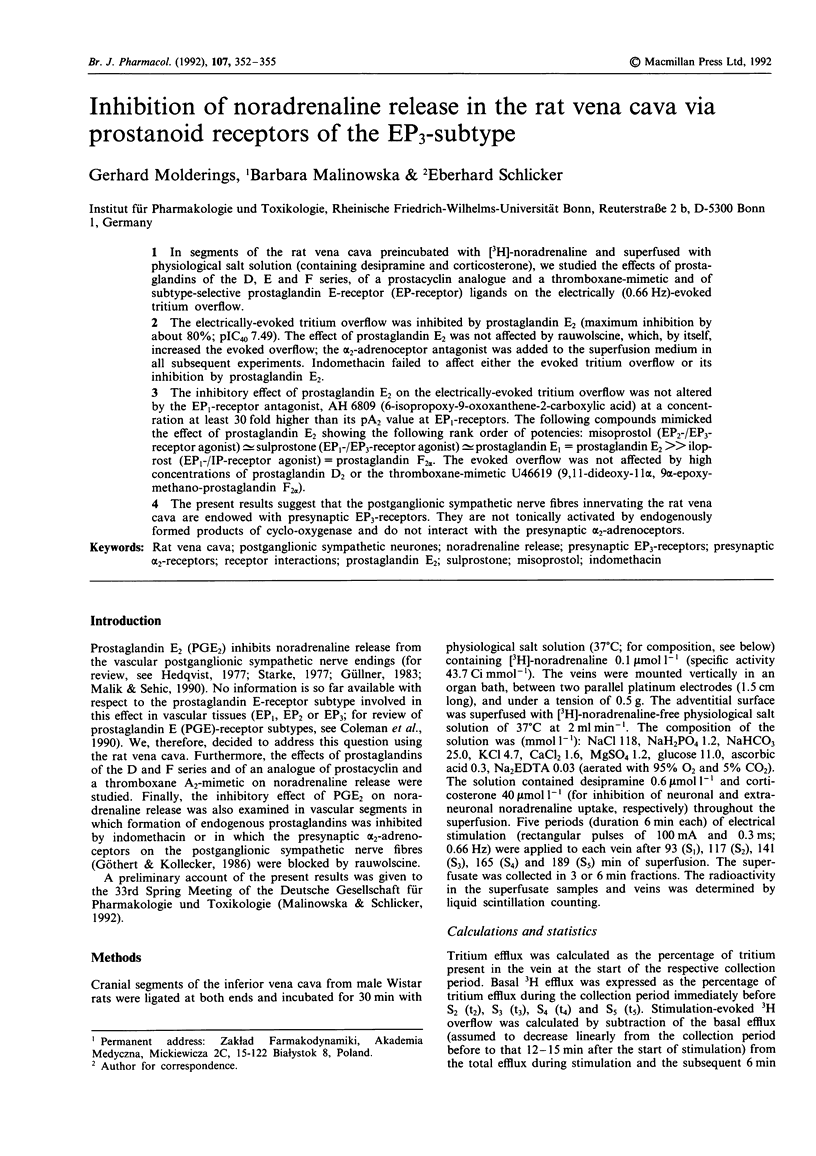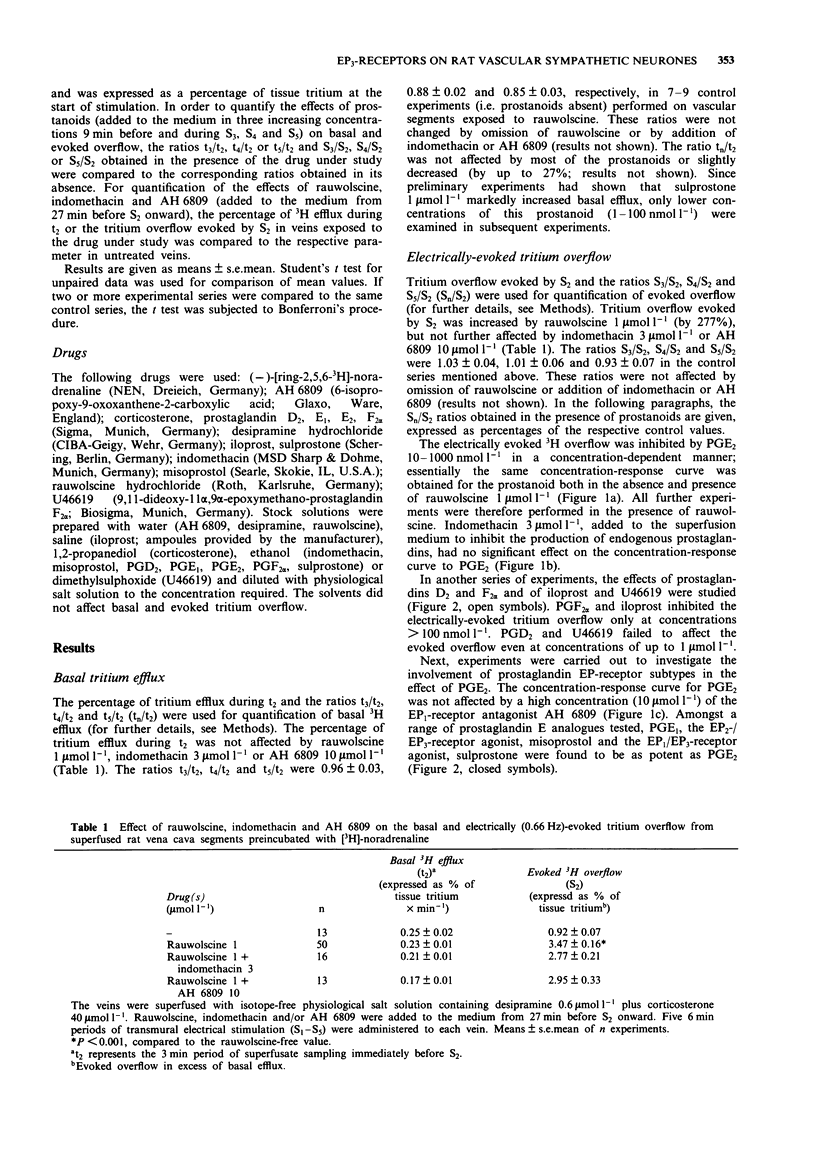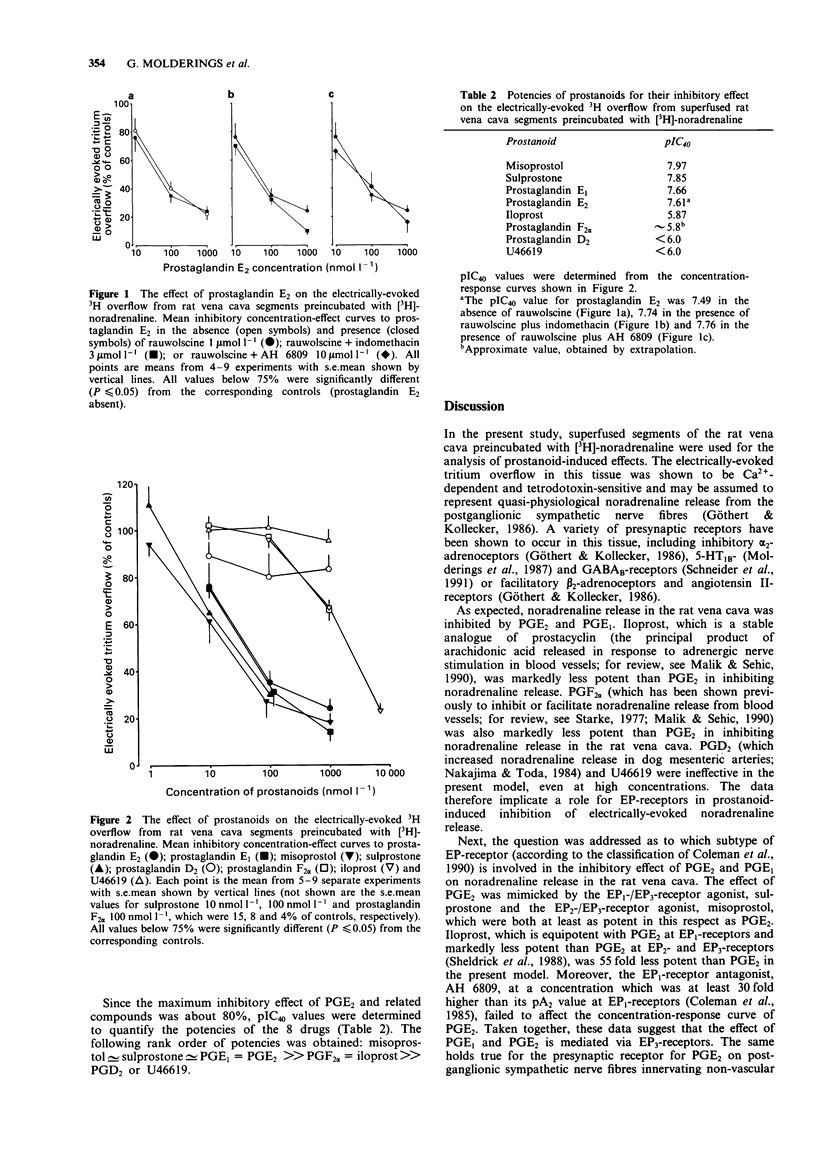Abstract
1. In segments of the rat vena cava preincubated with [3H]-noradrenaline and superfused with physiological salt solution (containing desipramine and corticosterone), we studied the effects of prostaglandins of the D, E and F series, of a prostacyclin analogue and a thromboxane-mimetic and of subtype-selective prostaglandin E-receptor (EP-receptor) ligands on the electrically (0.66 Hz)-evoked tritium overflow. 2. The electrically-evoked tritium overflow was inhibited by prostaglandin E2 (maximum inhibition by about 80%; pIC40 7.49). The effect of prostaglandin E2 was not affected by rauwolscine, which, by itself, increased the evoked overflow; the alpha 2-adrenoceptor antagonist was added to the superfusion medium in all subsequent experiments. Indomethacin failed to affect either the evoked tritium overflow or its inhibition by prostaglandin E2. 3. The inhibitory effect of prostaglandin E2 on the electrically-evoked tritium overflow was not altered by the EP1-receptor antagonist. AH 6809 (6-isopropoxy-9-oxoxanthene-2-carboxylic acid) at a concentration at least 30 fold higher than its pA2 value at EP1-receptors. The following compounds mimicked the effect of prostaglandin E2 showing the following rank order of potencies: misoprostol (EP2-/EP3-receptor agonist) congruent to sulprostone (EP1-/EP3-receptor agonist) congruent to prostaglandin E1 = prostaglandin E2 >> iloprost (EP1-/IP-receptor agonist) = prostaglandin F2 alpha. The evoked overflow was not affected by high concentrations of prostaglandin D2 or the thromboxane-mimetic U46619 (9,11-dideoxy-11 alpha, 9 alpha-epoxy-methano-prostaglandin F2 alpha). 4. The present results suggest that the postganglionic sympathetic nerve fibres innervating the rat vena cava are endowed with presynaptic EP3-receptors.(ABSTRACT TRUNCATED AT 250 WORDS)
Full text
PDF



Selected References
These references are in PubMed. This may not be the complete list of references from this article.
- Allgaier C., Jäger T., Hertting G. Endogenous noradrenaline impairs the prostaglandin-induced inhibition of noradrenaline release. Naunyn Schmiedebergs Arch Pharmacol. 1989 Oct;340(4):472–474. doi: 10.1007/BF00167051. [DOI] [PubMed] [Google Scholar]
- Göthert M., Kollecker P. Subendothelial beta 2-adrenoceptors in the rat vena cava: facilitation of noradrenaline release via local stimulation of angiotensin II synthesis. Naunyn Schmiedebergs Arch Pharmacol. 1986 Oct;334(2):156–165. doi: 10.1007/BF00505816. [DOI] [PubMed] [Google Scholar]
- Hedqvist P. Basic mechanisms of prostaglandin action on autonomic neurotransmission. Annu Rev Pharmacol Toxicol. 1977;17:259–279. doi: 10.1146/annurev.pa.17.040177.001355. [DOI] [PubMed] [Google Scholar]
- Hedqvist P. Prostaglandin action on noradrenaline release and mechanical responses in the stimulated guinea pig vas deferens. Acta Physiol Scand. 1974 Jan;90(1):86–93. doi: 10.1111/j.1748-1716.1974.tb05566.x. [DOI] [PubMed] [Google Scholar]
- Malik K. U., Sehic E. Prostaglandins and the release of the adrenergic transmitter. Ann N Y Acad Sci. 1990;604:222–236. doi: 10.1111/j.1749-6632.1990.tb31996.x. [DOI] [PubMed] [Google Scholar]
- Mantelli L., Amerini S., Rubino A., Ledda F. Prejunctional prostanoid receptors on cardiac adrenergic terminals belong to the EP3 subtype. Br J Pharmacol. 1991 Mar;102(3):573–576. doi: 10.1111/j.1476-5381.1991.tb12214.x. [DOI] [PMC free article] [PubMed] [Google Scholar]
- Molderings G. J., Fink K., Schlicker E., Göthert M. Inhibition of noradrenaline release via presynaptic 5-HT1B receptors of the rat vena cava. Naunyn Schmiedebergs Arch Pharmacol. 1987 Sep;336(3):245–250. doi: 10.1007/BF00172673. [DOI] [PubMed] [Google Scholar]
- Molderings G. J., Göthert M. Mutual interaction between presynaptic alpha 2-adrenoceptors and 5-HT1B receptors on the sympathetic nerve terminals of the rat inferior vena cava. Naunyn Schmiedebergs Arch Pharmacol. 1990 May;341(5):391–397. doi: 10.1007/BF00176329. [DOI] [PubMed] [Google Scholar]
- Nakajima M., Toda N. Neuroeffector actions of prostaglandin D2 on isolated dog mesenteric arteries. Prostaglandins. 1984 Mar;27(3):407–419. doi: 10.1016/0090-6980(84)90199-0. [DOI] [PubMed] [Google Scholar]
- Ohia S. E., Jumblatt J. E. Prejunctional inhibitory effects of prostanoids on sympathetic neurotransmission in the rabbit iris-ciliary body. J Pharmacol Exp Ther. 1990 Oct;255(1):11–16. [PubMed] [Google Scholar]
- Ohia S. E., Jumblatt J. E. Prejunctional prostaglandin receptors in the human iris-ciliary body. Curr Eye Res. 1991 Oct;10(10):967–975. doi: 10.3109/02713689109020333. [DOI] [PubMed] [Google Scholar]
- Schneider D., Schlicker E., Malinowska B., Molderings G. Noradrenaline release in the rat vena cava is inhibited by gamma-aminobutyric acid via GABAB receptors but not affected by histamine. Br J Pharmacol. 1991 Oct;104(2):478–482. doi: 10.1111/j.1476-5381.1991.tb12454.x. [DOI] [PMC free article] [PubMed] [Google Scholar]
- Starke K. Regulation of noradrenaline release by presynaptic receptor systems. Rev Physiol Biochem Pharmacol. 1977;77:1–124. doi: 10.1007/BFb0050157. [DOI] [PubMed] [Google Scholar]


